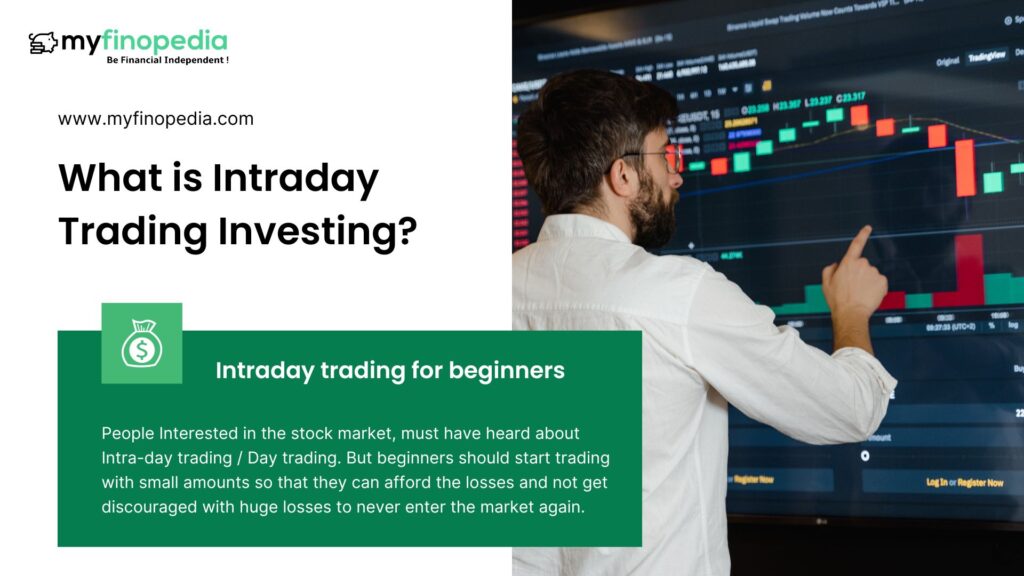People Interested in the stock market, must have heard about Intra-day trading / Day trading.
What a tempting way to attract profits right? Let’s understand about Intraday trading. It involves buying & selling stocks on the same trading day. Fluctuation in share price is analyzed through technical indicators and from these price movements, profit is generated.
If you fail to close your position in intra-day trading, it gets squared off automatically at the market closing price.
Advantages of Intraday trading
- Lower Risk of overnight loss
When you do intra-day trading, you protect yourself from the loss that happens due to news after the closing of the exchange. For example – the X company is alleged of tax evasion if this news comes out in the news after the closing time of the exchange. The next day the share price of the X company will open with the price lower than the previous day’s closing price. - Lower Commission charges
You have to pay lower commission charges for Intraday trading as compared to other types of trading. - Higher profits
Through Intraday trading, you can generate high profits, without investing the complete amount required for buying or selling a stock price. The margin requirement by brokers is to be paid only.
Disadvantages of Intraday trading
- No ownership
The trader does not own the shares, he traded for the day. - High Volatility
Traders can incur losses if the market is unfavourable. Day trading requires years of professional experience to generate consistent profits.
Rules to follow while doing Intraday trading:
➡️ Know when to enter and to exit.
➡️ Use stop loss always
➡️ Do not panic sell or buy
➡️ Start with small amounts, which you can afford to lose.
➡️ Avoid penny stocks.
To understand Intraday trading, the following indicators are important to understand.
- Moving average
Most commonly and widely used indicator. It connects the average closing rates over a specific period. It is based on historical data. Keeping in mind that history repeats itself, the longer the period, the more reliable the moving average.
One popular combination is the use of the moving average & the Relative Strength Index (RSI).
The relative strength index is a technical indicator used in the analysis of the financial market.
It calculates the magnitude of recent price changes to determine overbought or oversold conditions in the market.
RSI is calculated by taking the average of up to 14 days’ closing prices & dividing the standard deviation of those prices.
Below 30 – oversold conditions
Above 70 – overbought conditions
- Volume-weighted average price (VWAP)
It shows the average price at which an asset is traded through the trading session considering the volume of transactions. VWAP resets at the start of every new trading session.
Traders may use VWAP as a trend confirmation tool because the greater the volume, the better the direction is confirmed.
Stocks with prices below VWAP are good to buy as they are undervalued and those with prices above it are good and are overvalued.
VWAP is a single-day indicator & restarts at the opening of each new trading day. Attempting to create an average VWAP over many days could distort it and result in an incorrect indicator.
- ADX ( Average Directional Index)
It is used to identify strengths for an ongoing trend. We should never trade against the trend. So to know the strength of a trend, it is used.
If the value of an ADX indicator rises above 25, it indicates a strong trend, bearish or bullish.
The fall of ADX is not a signal of a trend reversal, it only tells about the weak strength of the trend.
It is a lagging indicator, generally slow to respond to dynamic market changes, and therefore may not reflect accurate market conditions. It gives only information on the trend. Traders need to rely on supplementary indicators to identify entry & exit conditions.
In the case of a sideways market, it is not useful for traders.
Myths that surround Intraday trading
- Trading is gambling – As we have seen above there are indicators, charts, and many other tools used as supplementary for effective trading. It is like a mathematically calculated, technically analyzed business. Do not invest money in trading as you do in gambling.
- There is a chance to tame the market – There is no secret to constantly win the stock market. Stock market works on the sentiments of investors and there is no correct or accurate approach to calculate the same. The only key to success in the market is excellent analysis.
- Higher leverage means higher profits – This is a flawed misconception. Leverage never assures return. You might have profits or losses, but both go to the same length in either direction. It all depends on your understanding of the market & how we’ll market behavior resonates with your view.
- The more the indicator, the better – One should consult more than one indicator whereas a beginner can end up confused around them. Hence choose your indicators after careful analysis & learning everything about how they operate.
In conclusion, success in Intraday trading depends on how much effort you put into understanding the market, and gradually experience also teaches you a lot. But beginners should start trading with small amounts so that they can afford the losses and not get discouraged with huge losses to never enter the market again.






